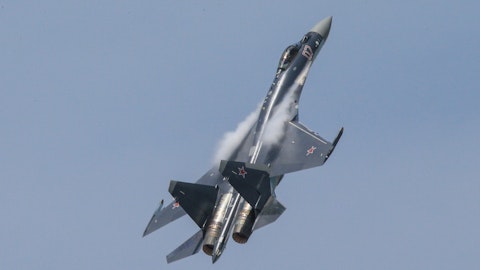Operator: Thank you. The next question is from the line of Ron Epstein from Bank of America. Please go ahead.
Ronald Epstein: [indiscernible] question.
Jim Taiclet: Hey, Ron.
Ronald Epstein: I’ll do the question first. What are you thinking about the opportunity for the Black Hawk going forward, meaning I don’t know, we’ve kind of heard there’s some challenges on future vertical lift. And what opportunities does that open to you for the Black Hawk?
Jim Taiclet: Ron, it’s Jim. Look, the Black Hawk, and I’ve gotten a flight autonomously and by hand actually. I think has a lot of potential. There’s interesting Congress for modernization of the Black Hawk. There’s a huge fleet out there. And by adding some of these digital capabilities like autonomy and AI to the Black Hawk, which is a really reliable platform that’s offline in units today in great numbers and across our allies. That’s a real, I think, value opportunity for the Army’s in ring cores and others that use the helicopter. So I do think there’s a lot of upside there. I don’t want to comment on anybody else’s programs or how well or not they may be doing, but this is a proven scaled vehicle with digital technology upgrade and insertion can be very, very versatile.
And that can be done much more rapidly than new production of new aircraft. So I do think that there is upside there. Now the services and Congress have to agree. And to that and fund those modernizations and keep those units flying. And that will be up to them. But we are trying to provide them every opportunity to make that decision by inserting digital and other technologies like autonomy that will really make the aircraft much more capable in doing missions like air evacuation, resupply of the hot landing zone, things like that, that when you put it into the entire equation, of completing a mission, it will be a good value to consider it.
Operator: Thank you. And our next question is from the line of Kristine Liwag from Morgan Stanley. Please go ahead.
Kristine Liwag: Hey, Jay, Jim, I mean, there’s been discussion in the public markets about the depletion of U.S. missiles ammunitions and a potential shortage mean that side from your commentary today, it sounds like supply chain issues continue to linger, weighing on the company’s ability to convert the demand into revenue. So can you talk more about the additional actions you’re taking to improve the supply chain’s ability to get products through the system? And what metrics are you monitoring? And how much upside could you see in 2024 if things improve?
Jim Taiclet: I’ll make a couple of comments and ask Jay to follow. The steps that we’re taking to take the fragility out of the missile production system are varied. One of them is — and it’s very specific, we are endeavoring to stand up a third solid rocket motor supplier in the United States that can be additive to the industry supply chain we have today, which hasn’t been performing well, right? That’s one piece. More broadly, we’re using additive manufacturing, and we’re bringing in more varied suppliers into the supply chain, so that we can get the materials we need from a more diverse set of group of suppliers outside of solid rocket motors. And also, we’re looking at international opportunities to build this equipment including in Australia and in Poland, U.K. and others are kind of on tap for coproduction or joint ventures with us to do these things, in Germany, I should mention as well.
So these are some of the approaches we’re taking. And it really comes down to these three areas, which is how can we on one hand take basic steps in anti-fragility to more suppliers, more diversity on the supply chain, different labor pools, better training, those kinds of things where it’s just basic. Secondly, how can we insert technology to make this more reliable production system, which we just mentioned. And then thirdly is how do we get international countries and take advantage of their labor forces, their supply to sub-supply chains, et cetera, and get them into the production system. So we look at this in all three areas of our core company strategy and apply it to missile production. Jay, anything you want to add?
Jay Malave: Yes. I’ll just say over the last year, Kristine, we’ve deployed resources. So we haven’t just sat back and waiting for improvement. Depending on the supplier, depending on the issues, we have deployed manufacturing engineering resources. We’ve deployed quality engineering resources and program management resources as well as, in certain cases, we’ve actually deployed hourly workers to support suppliers in certain cases. And so we’ve taken an all-hands on deck approach, where we’ve seen the issues become more significant. And we’ve done everything we can to support these suppliers and help them get through. I would expect that to continue where we see these bottlenecks. But as I mentioned earlier, we did see some general improvement.
We are expecting that improvement to continue. And in terms of potential upside, what I would point you to is that if we’re able to unlock and see a little bit better performance and that what drives to the high end of our sales profit and EPS range.
Operator: Thank you. Our next question is from Matt Akers from Wells Fargo. Please go ahead.
Matthew Akers: Hey, good morning. Thanks guys. Could you touch on F-16 real quick, just latest thoughts on the ramp rate here and also just margins on that program that compares to the segment now? And then sort of do they get better over time as you kind of come back down learning curve?
Jay Malave: Yes. So we delivered five aircrafts in 2023. We would expect that to triple potentially quadruple here in 2024. And so we’re — the ramp is certainly in full force. We’ve got over 30 aircraft there in WIP as we ended the year. And so that is, I think, from a delivery standpoint, increasing the production cadence is all trending well. From a profitability standpoint, you may recall, we’ve had some pressure because it’s taken us longer to get to this point. And so that puts some pressure on our initial contracts. Here, as we fully deliver those out and deliver on the subsequent contracts, we will see profitability improve on the F-16 over the next few years.




